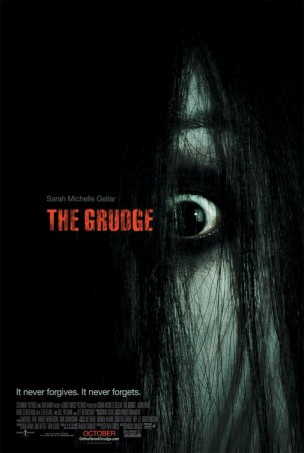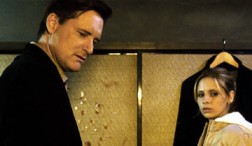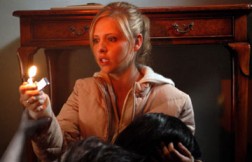|
The
Grudge
I’m compelled to shamefully clarify that I have yet
to see Ju-On, the original Japanese horror film
upon which The Grudge is based. Okay, scoff for
a second while I regain composure.
This
is not to say that this is unfamiliar territory, having
screened a bevy of other Japanese horror films prior to
last night’s screening.
The
big news for horror fans in 2002 was the arrival of Gore
Verbinski’s The Ring,
a remake of Ringu, by Hideo Nakata. This practice
is not new ground for Hollywood, as mining foreign film
for notably brilliant work and then snatching up the rights,
hiring a new “all-American” cast and dubbing
it an instant classic has become one of the defining traits
of the new “studio” system.
In this
case, studio means “watch the buzz” and “grab
the rights.”
Verbinski’s
film was a notable hit; actually that’s softening
it a bit. The word-of-mouth response from American moviegoers
was so huge that it ignited an immediate focus on all things
filmic in the “horror” and “Asia”
departments.
So this
brings us back to The Grudge, starring Sarah Michelle
Gellar. Scary enough yet? You have no idea. However there
are some soothing aspects to the re-creation process this
go ‘round. First off, Takashi Shimizu, the original
director behind the Ju-On series, was retained for the remake.
Then
word gets out that horror uber-meister and Spidey helmer
Sam Raimi is involved in the U.S. update, and that makes
two plusses in its corner. But Buffy? As opening credits
progressed it occurs to me that not only is Raimi on board,
but his old Evil Dead partner-in-crime Rob Tapert is riding
shotgun and his brother Ted (best known for his work as
a Fake Shemp) is along for the ride in the backseat. Things
just got interesting.
Apparently
Raimi is a big fan of Ju-On, and it shows in the
production team’s choice for Director and the film’s
adherence to the style, location, and feel that makes Japanese
horror films so intriguing. All of the staples are here,
the use of technology to comment on our societal reliance
on the inanimate, and my personal favorite, the use of mirrors
to reflect what could or could not be lurking around corner
and into the souls of these tortured characters.
Right from
the start the opening sequence grabs a hold tightly, and the
film will not let go until its final moments. The absorbing
aspect that makes The Grudge so engrossing is its
complicated narrative structure, which just so happens to
be the trait that critics are taking it to task on.
The
film begins as a series of vignettes, introducing us to
a string of characters that are each related, although we
have no idea how or why. Bill Pullman lands an opening as
Peter that will be discussed for sometime. Unexpected, jaw-dropping,
this is what good Japanese horror is about.
We finally
meet Karen (Sarah Michelle Gellar), a young nurse living
in Japan with her student boyfriend Doug (Jason Behr). We
learn that she accompanied him in to Japan because he has
always dreamed of studying there, and she loves him enough
to follow in tow.
Karen
is picked to cover a shift for a co-worker named Yoko (a
quick scan of the cast list at IMDB.com fails to turn up
the actresses name, my apologies to her), when she fails
to show up for work the next day. Yoko’s job is to
care for the aging Emma (Grace Zabriskie) who happens to
live in a possessed house.
What
Karen finds in the house is not the beginning of the story.
It is rather an introduction to the story from her point
of intersection with the events that have transpired thus
far. The vignette-style continues, inter-cutting the past
with present, showing us how Emma arrived at the house,
her family and their individual fates, all while Karen learns
more about the house and its inhabitants.
This
is a huge advantage for the film, because just as audiences
feel they have their collective heads wrapped around the
events transpiring, something occurs which complicates the
theory and leaves them wondering what will come next.
Not
to drudge into the details; instead, let's clarify how Japanese
horror transcends the classically clichéd motifs
found in modern horror films these days. To do this, examine
the constructs of horror itself.
First
of all, we have the introduction to the evil that will plague
the characters in the film. This is a pivotal aspect in
horror film, because it must effectively reveal how the
evil works, but remain mysterious enough to hold intrigue
and mask any weaknesses the predatory evil may have. We
must leave those to the hero (or in many cases heroine)
to figure out.
Secondary,
there is always candid expository sequences in which the
evil targets the hero, and subsequently he or she must investigate
the causes behind the attacks that are picking off other
characters in the film.
In the
end, we find resolve. Our hero finds a way to exploit weakness
and overcome evil, usually by finding a newspaper clipping
or some other overlooked clue by others in the process of
their investigation.
The
Grudge contains all of these aspects, but it doesn’t
play fair with these standards and that is a good thing.
Audiences are used to seeing characters back themselves
into precarious situations, usually to the extent that we
take comfort in thinking to ourselves, “if it were
me I would have never done that…”
This
mode of comfort is established early on in The Grudge,
but it doesn’t last for long, and this makes the film
all the more frightening. Japanese horror in general utilizes
the clichés of modern horror to induce its scares,
and it works. Things occur when its least expected, and
the tired tricks are often turned on their ear.
At one
point in the film, as a young caretaker examines the haunted
house, we are presented with a common horror dilemma. A
creaky noise is heard, it seems to be coming from the closet.
The character is faced with two choices: 1) run like mad
from the house, or 2) investigate the closet.
Choosing
the latter is prerequisite in a horror film, but in most
cases it turns out to be a rat, or a cat, or some other
furry creature that is revealed for shock. This is used
to relax the audience for a moment until the character turns
to find something more frightening hiding just off-screen,
or creeping up behind them, which devours them whole and
produces the real scare.
Right?
Usually
yes. This time it is a cat, but it’s not what is out
of eyeshot when the cat is revealed that causes the true
scare, it’s what’s holding the cat that sends
a chill down our spine.
Post-Script:
Many rejoice in shielding their eyes from films like this,
seeking solace so they may find a way get unfettered rest
when it comes time to sleep. The Grudge manages
to fuse its images onto the backs of a viewer’s eyelid,
and thanks to the excellent sound work, hearing in many
cases is far more frightening then actually seeing.
Rating:

|








